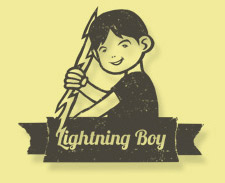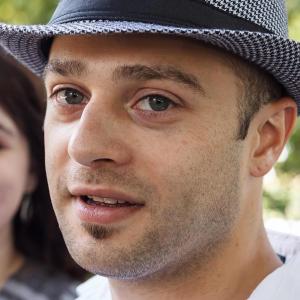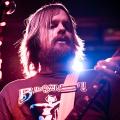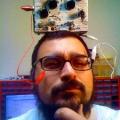 I’ve been paying close attention to a new builder for me – Lightning Boy Audio. I’ve been following them on Facebook for a while, and I’ve been really interested in what these guys have been up to. They just recently released the Lightning Boy Audio Olympus – which is a monster pedal, basically an amp in a pedal. We’re talking 3 channels and 4 NOS JAN 5814 tubes. Who makes a pedal with 4 tubes in there? Lightning Boy, that’s who! They also offer the Soul Drive – which is a drive pedal that has a single 12AU7 preamp tube, NOS paper in oil caps and hand made paper in oil caps! They also go beyond pedals and offer recording studio equipment – introducing the VOG Reverb (Voice of the Gods). This is a classic EMT plate reverb from the golden age of recording. We’re talking 7′ x 4′ and weighs 200 pounds!
I’ve been paying close attention to a new builder for me – Lightning Boy Audio. I’ve been following them on Facebook for a while, and I’ve been really interested in what these guys have been up to. They just recently released the Lightning Boy Audio Olympus – which is a monster pedal, basically an amp in a pedal. We’re talking 3 channels and 4 NOS JAN 5814 tubes. Who makes a pedal with 4 tubes in there? Lightning Boy, that’s who! They also offer the Soul Drive – which is a drive pedal that has a single 12AU7 preamp tube, NOS paper in oil caps and hand made paper in oil caps! They also go beyond pedals and offer recording studio equipment – introducing the VOG Reverb (Voice of the Gods). This is a classic EMT plate reverb from the golden age of recording. We’re talking 7′ x 4′ and weighs 200 pounds!
Be sure to check out their site and like their page on Facebook!
Below is an interview with the Lightning Boy Audio Engineer – Mike Congilosi II
 When did Lightning Boy Audio get its start?
When did Lightning Boy Audio get its start?
It started under various names that didn’t stick about 2 years ago, but the name Lightning Boy came into being sometime last year, so we’re still a pretty new company.
Where did the name come from?
That’s kind of a funny story because I’m still alive. I was racking up and modding a pair of vintage Yamaha PM1000 channel strips for a client’s studio when the idea struck me. I had the cover off the dual PM1K box and everything was plugged in as I started testing it. My hand accidentally touched the contacts of the power switch, giving me the great experience of 110v AC. Need I say more? Lol
What kind of gear does Lightning Boy produce? It sounds like you have some experience with recording studio equipment.
Yeah, actually before Lightning Boy Audio I wasn’t building any FX pedals. I was building recording studio equipment and repairing tube guitar amps. That’s how I came to realize how much I love the sound of vintage tube gear. So much in fact that I decided LBA’s main focus would be on building tube gear in the old school fashion of point-to-point wiring. We’re currently offering 2 different tube-based pedals and we have plans for a bunch of tube based studio gear in the near future.
What inspired the creation of Lightning Boy Audio as a company?
It started when I acquired an empty recording studio space and decided to set up shop there as Gallery Acoustics Recording Studio. I went to college for Producing and have been a Recording Engineering for about 13 years, so this facility was a blessing for me. I realized I needed a lot more high-end studio gear than what I had, but didn’t have enough funds to buy everything I needed.  The logical solution for me was to build most of the stuff instead. The first thing I built was a series of progressively more complex summing boxes for mixing, but eventually I picked up a mixing board. After building a bunch of passive devices like a really awesome monitor controller, a DI box and a bunch of headphone volume control boxes I decided to build some clones of the gear I really wanted. I ended up putting together some great sounding compressors like a pair of Teletronix LA2A’s loaded with all NOS components and built to the specs of the 1960’s version. My real passion was discovered when I built a clone of the famous Pultec program equalizer. I really love designing and building vacuum tube based passive EQ circuits. This love of mine found its way into our newest pedal, Olympus.
Enough people told me for a while that I had a skill and could make a successful business out of building gear, so I started taking them seriously. The first product I designed under the Lightning Boy brand was Soul Drive, a tube overdrive pedal.  And now after appx 15 months of development and user feedback we are proud to release Soul Drive 3, which in my opinion is a very mature and thoroughly perfected design. We are also now just releasing our second product, Olympus, which is a multi-channel tube pedal with a hoard of powerful features. Gallery Acoustics is still a recording studio open to the public, but it is also the test bed for all LBA gear.
What got you interested in electronics?
My earliest memory of electronics tinkering was a Christmas gift of some electronics project kit when I was kid. I’m sure my parents got me that because I was taking everything apart and not putting it back together. I remember building a simple battery powered radio and being completely amazed with it. That was probably the first spark. I really didn’t start getting seriously into it until I got my first electric guitar around the age of 14. Dad spent way too much money on it and couldn’t buy me an amp as a result. I blew out a few stereo systems over time as they were jerry rigged to work as guitar amps. I eventually bought my first guitar amp… which actually wasn’t a guitar amp at all. It was a keyboard amp. I picked it up because it had RCA outputs, mic inputs and built in reverb. I was very interested in recording at this point and it was an easy way for me to get my sounds running into my Pioneer tape deck.  In my senior year of high school I spent my time in shop class and at Grandpa Joe’s shop building an electric guitar from scratch, which I still play to this day.
What inspired the pedals you’re building?
Like all things for me it was a lack of money, yet a desire to have the absolute best gear for my studio. My opinion of the best sounding gear is hand-wired, point-to-point tube gear made with super high quality components. I thought if I could somehow cram all that thick beautiful tone into a stomp box, I’d have something pretty special. That’s how Soul Drive came into being. It’s made with NOS tubes and NOS paper in oil caps, like Olympus and the studio gear I’ve made.
What would you say separates LBA from other builders?
There are many answers to that question. Number one would have to be the Lightning Boy Audio Thunder Cap. Guitar players have been buying up NOS paper in oil tone caps for their guitars quite a bit over the past few years because they realized what the audiophile community has known for decades. PiO caps sound smoother and more transparent than any other type of cap when it comes to audio signals. Unfortunately, there is a limited World-wide supply of NOS caps and its dwindling fast as prices skyrocket. Fortunately, I’m actually making paper in oil caps by hand and putting them into everything I build! I doubt there’s anyone else out there doing this.  I also build inductors from scratch whenever I’m putting together an inductor based EQ. My prototype SPEQ-1 passive studio EQ uses both Thunder Caps and my hand wound inductors to deliver a really smooth and slightly colorful tone.
Aside from manufacturing some of our own components, the components I buy are always Military-grade and often sourced from the USA. I use aerospace purposed Teflon insulated silver-plated stranded wire for every piece of equipment I build and its always hand soldered point-to-point using silver solder. Even if other builders say they don’t cut corners, I doubt they are going to this level of detail. It’s very expensive to build with the best mankind has to offer, but to do it at a price that’s affordable is what really sets Lightning Boy Audio apart from the rest.
What would you say is the element that defines Lightning Boy the most?
Everything is built exclusively with paper in oil caps. That’s a huge thing that adds a tremendous amount of mojo to our builds. These pedals are seriously oozing high fidelity tone. They are designed to kick ass under the microscopic scrutiny of the recording studio.
When designing circuits, what is your main goal and is there anything you try to avoid?
My main goal is always to achieve the greatest degree of sonic fulfillment. I’ll tweak a circuit until it sounds better than anything I’ve heard before and if it doesn’t get to that point I’ll scrap it and move to a better idea. The main thing I try to avoid like the Black Plague is noise. I hate noise so much and when you’re in the studio, even the slightest amount of noise is significant. If you’re recording a bunch of tracks on top of each other and each one has a little noise, it will compound and the end result will be the sum of all the noise. Noise is inevitable in all audio circuits, but I strive to keep it as low as possible through good designing, time-tested wiring techniques and component selection through listening.
Is there any particular type of musician who would be interested in Lightning Boy Audio pedals?Â
Definitely the tone junkies. Those who are in search of the holy grail of tone will find comfort in Lightning Boy Audio.
Where is the best place to pick up a Lightning Boy pedal?
www.lightningboyaudio.com is the best place. If you’re in the Western Part of New York State, the legendary House of Guitars would be a good place to take a test drive. You could also arrange a visit at Gallery Acoustics if you’re in the area. www.galleryacoustics.com





Leave a Reply